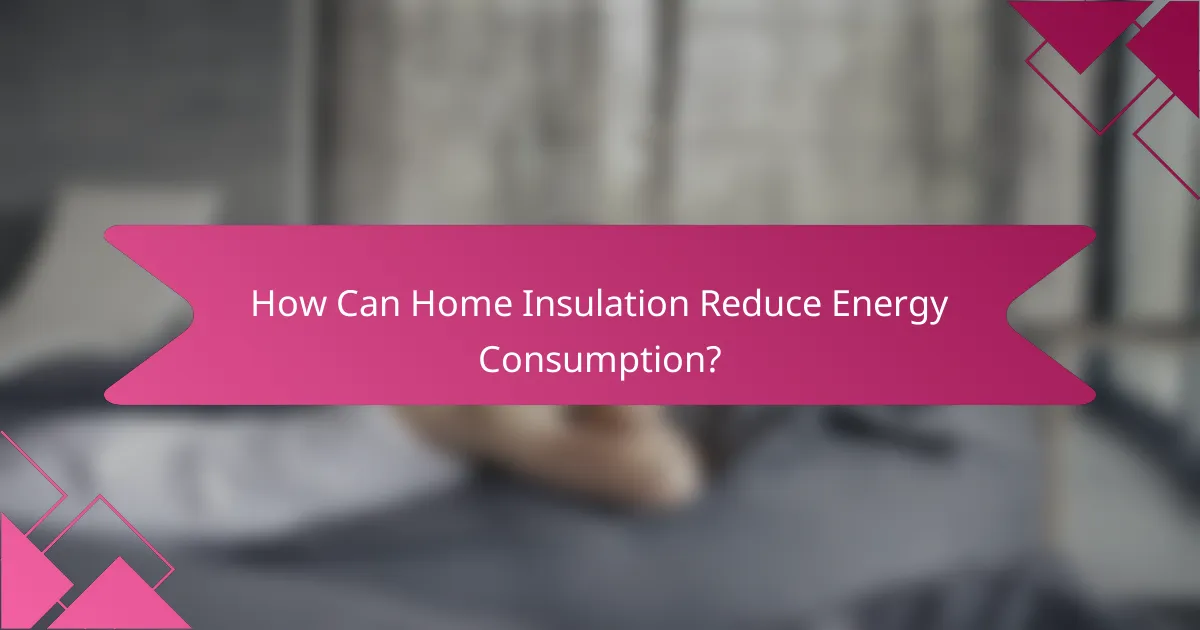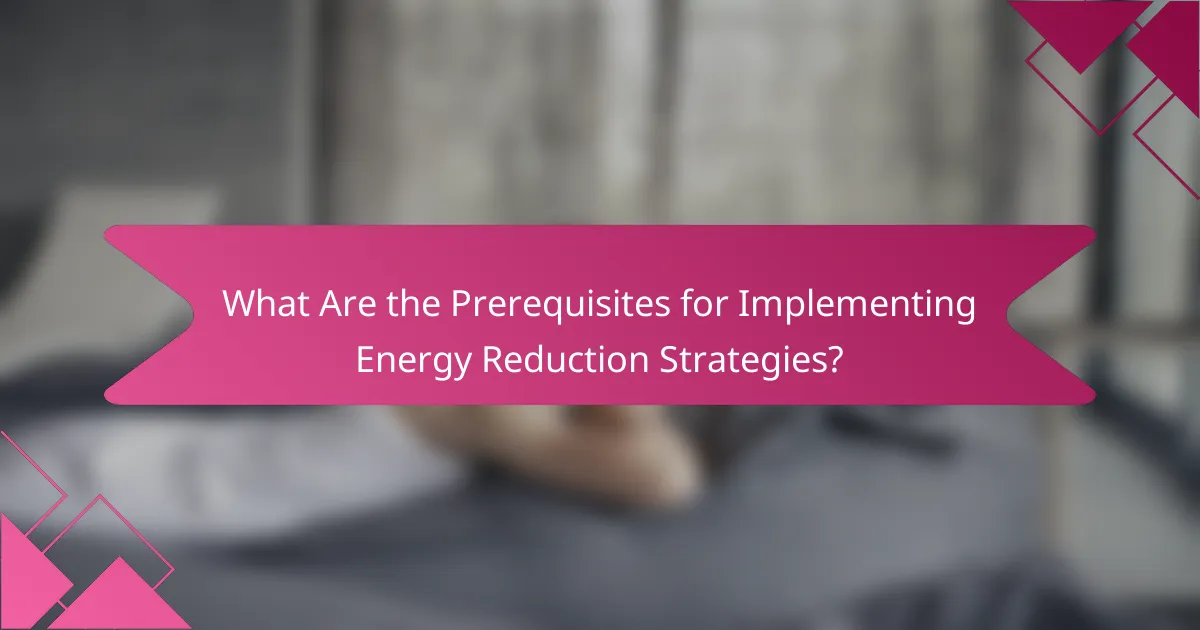Reducing energy consumption in homes is essential for both cost savings and environmental sustainability. Key strategies include enhancing home insulation to minimize heat transfer, utilizing efficient appliances that consume less energy, and implementing smart thermostats that optimize heating and cooling based on user habits. Together, these measures can significantly lower utility bills and contribute to a greener future.

How Can Home Insulation Reduce Energy Consumption?
Home insulation significantly reduces energy consumption by minimizing heat transfer, keeping homes warmer in winter and cooler in summer. This leads to lower heating and cooling costs, making insulation a crucial investment for energy efficiency.
Types of insulation materials
Common insulation materials include fiberglass, foam board, spray foam, and cellulose. Each type has unique properties; for instance, fiberglass is cost-effective and fire-resistant, while spray foam provides superior air sealing. Choosing the right material depends on factors like climate, location, and budget.
Benefits of proper insulation
Proper insulation enhances comfort by maintaining consistent indoor temperatures and reducing drafts. It also lowers energy bills by decreasing reliance on heating and cooling systems. Additionally, well-insulated homes can increase property value and improve indoor air quality by preventing moisture buildup.
Cost savings from insulation
Investing in insulation can yield significant cost savings, often recouping the initial investment within a few years through reduced energy bills. Homeowners may save anywhere from 10% to 50% on heating and cooling costs, depending on the effectiveness of the insulation installed. Various incentives and rebates may also be available to offset installation costs.
Insulation installation options
Insulation can be installed as a DIY project or by professionals, depending on the complexity and type of insulation. DIY options like fiberglass batts are accessible for many homeowners, while spray foam and blown-in cellulose typically require professional installation. It’s essential to assess your skills and the specific requirements of your home before deciding.
Energy efficiency ratings
Insulation materials are rated by their R-value, which measures thermal resistance. Higher R-values indicate better insulating properties, with values typically ranging from R-13 for walls to R-60 for attics in colder climates. When selecting insulation, consider local building codes and energy efficiency standards to ensure compliance and optimal performance.

What Are Efficient Appliances for Energy Savings?
Efficient appliances are devices designed to use less energy while maintaining performance, significantly reducing energy consumption and costs. These appliances often meet specific energy efficiency standards, making them a smart choice for environmentally conscious consumers and those looking to lower their utility bills.
Energy Star certified appliances
Energy Star certified appliances meet strict energy efficiency guidelines set by the U.S. Environmental Protection Agency. These appliances can use 10-50% less energy compared to standard models, making them a reliable option for energy savings. Look for the Energy Star label when shopping to ensure you’re choosing an efficient product.
Comparative energy consumption
When comparing energy consumption, consider the annual energy use of appliances, often measured in kilowatt-hours (kWh). For example, an efficient refrigerator may consume around 300-500 kWh per year, while a standard model could use 600-800 kWh. This difference can translate into significant savings on your energy bill over time.
Long-term cost benefits
Investing in efficient appliances can lead to substantial long-term cost benefits. Although the initial purchase price may be higher, the reduced energy bills can offset this cost within a few years. Additionally, many efficient appliances come with warranties that can further enhance their value by minimizing repair costs.
Popular efficient appliance brands
Several brands are well-known for their commitment to energy efficiency. Brands like Whirlpool, Samsung, and LG offer a range of Energy Star certified appliances. Researching customer reviews and energy ratings can help you choose the best options for your home while ensuring you benefit from energy savings.

How Do Smart Thermostats Contribute to Energy Efficiency?
Smart thermostats enhance energy efficiency by automatically adjusting heating and cooling settings based on user behavior and preferences. They optimize energy use, leading to reduced utility bills and a smaller carbon footprint.
Features of smart thermostats
Smart thermostats come equipped with various features that promote energy savings. Many models include learning algorithms that adapt to your schedule, allowing them to adjust temperatures when you’re home or away. Additionally, remote access via smartphone apps enables users to control their heating and cooling systems from anywhere.
Other notable features include geofencing, which uses your smartphone’s location to adjust settings when you leave or return home, and energy usage reports that provide insights into your consumption patterns. Some models also integrate with voice assistants for hands-free control.
Energy savings statistics
Studies suggest that smart thermostats can save homeowners between 10-15% on heating and cooling costs annually. This translates to potential savings of around $100 to $150 per year, depending on your energy rates and usage patterns.
Moreover, users often report additional savings when they utilize features like scheduling and geofencing, as these capabilities help minimize energy waste during unoccupied periods.
Integration with home systems
Smart thermostats can seamlessly integrate with various home systems, including HVAC units, smart lighting, and security systems. This integration allows for coordinated energy management, enhancing overall home efficiency.
For instance, when paired with smart blinds, a thermostat can adjust the temperature based on sunlight exposure, further optimizing energy use. Additionally, many smart thermostats are compatible with popular home automation platforms, making it easy to incorporate them into existing smart home ecosystems.
Popular smart thermostat models
Several smart thermostat models are widely recognized for their efficiency and features. The Nest Learning Thermostat is known for its intuitive learning capabilities and sleek design, while the Ecobee SmartThermostat offers room sensors for more precise temperature control.
Other notable models include the Honeywell Home T9, which provides robust scheduling options, and the Emerson Sensi Touch, known for its user-friendly interface. When choosing a model, consider factors such as compatibility with your HVAC system and desired features to maximize energy savings.

What Are the Prerequisites for Implementing Energy Reduction Strategies?
To effectively implement energy reduction strategies, homeowners should first assess their current energy usage, establish a budget, and explore local energy efficiency programs. These steps are essential for identifying opportunities and maximizing savings.
Home assessment requirements
A thorough home assessment is crucial for understanding energy consumption patterns. This typically involves evaluating insulation levels, window efficiency, and the performance of heating and cooling systems. Homeowners may consider hiring a professional energy auditor to pinpoint areas for improvement.
During the assessment, look for common issues such as air leaks around doors and windows, inadequate insulation in attics or walls, and outdated appliances. Addressing these can lead to significant energy savings.
Budget considerations
Establishing a budget is vital for implementing energy reduction strategies. Homeowners should consider both upfront costs and long-term savings when investing in insulation, efficient appliances, or smart thermostats. A common guideline is to allocate 5-10% of your home’s value for energy upgrades.
It’s important to weigh the cost of improvements against potential energy savings. For example, while high-efficiency appliances may have a higher initial price, they can reduce energy bills significantly over time, often paying for themselves within a few years.
Local energy efficiency programs
Many regions offer energy efficiency programs that provide financial incentives for homeowners. These programs can include rebates for energy-efficient appliances, grants for insulation upgrades, or low-interest loans for comprehensive energy renovations. Check with local utility companies or government websites for available options.
Participating in these programs can greatly reduce the overall cost of energy improvements. For instance, some states in the U.S. offer rebates that can cover a portion of the costs for installing smart thermostats or upgrading insulation, making these strategies more accessible.

How to Choose the Right Energy Reduction Solutions?
Selecting the right energy reduction solutions involves evaluating your home’s insulation, the efficiency of appliances, and the use of smart thermostats. Prioritize options that align with your budget, energy goals, and specific home characteristics for optimal results.
Factors to consider
When choosing energy reduction solutions, consider the age and condition of your home, local climate, and energy costs. For instance, older homes may require more extensive insulation upgrades, while newer builds might benefit from efficient appliances and smart technology.
Evaluate the upfront costs versus long-term savings. Energy-efficient appliances often have higher initial prices but can lead to significant savings on utility bills over time. Additionally, check for local incentives or rebates that can offset initial investments.
Comparative analysis of options
Home insulation typically involves materials like fiberglass, foam, or cellulose, each with varying R-values, which measure thermal resistance. Higher R-values indicate better insulation performance, which is crucial for energy conservation.
Efficient appliances, such as those with ENERGY STAR ratings, use less energy than standard models. For example, ENERGY STAR refrigerators can use 15% less energy than non-rated ones, translating to lower monthly bills.
Smart thermostats offer the ability to optimize heating and cooling schedules, potentially reducing energy usage by 10-15%. They can learn your habits and adjust settings automatically, providing convenience and savings. Compare features like remote access and integration with other smart home devices to find the best fit for your needs.


